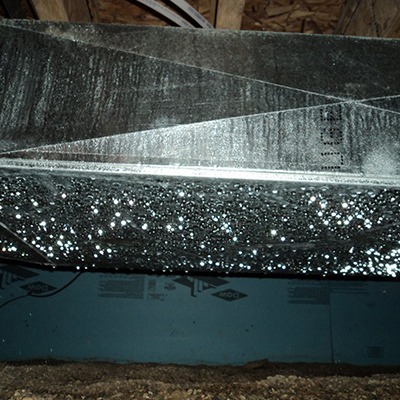High Humidity Levels:
When relative humidity is high, condensation can form in air ducts. Duct walls and vents are cooler than the air outside, which can cause condensation to form as warm, humid air moves through the system. Condensation results from the air’s reduced ability to hold moisture as it cools. This happens frequently in places with a lot of humidity or in places where ducts pass through unconditioned rooms like basements or attics.
Poor Air Duct Insulation:
Condensation is made worse by air ducts with inadequate insulation. In order to keep heated air from rapidly cooling to the point where condensation occurs, insulation aids in maintaining consistent temperatures within the ducting. Sweating is more likely to occur in ducts that are in poorly insulated or unconditioned areas. The efficiency of the insulation can be compromised by corrosion or degradation, which can lead to water seeping into the duct walls.
Temperature Differential:
One further thing that might cause duct sweating is a temperature differential between the air within the ducts and the outside air. Condensation is more likely to happen if the air within the ducts is much cooler than the outside air. During the summer, when air conditioners are turned on often to cool the air within the ducts, this temperature difference is usually more noticeable. Similarly, when warm air flows through ducts that are exposed to chilly external temperatures in the winter, condensation can also form.
Air Leakage:
Warm, humid air from nearby spaces may enter ductwork through air leaks, which raises the possibility of condensation. Air from the outside can enter the system through cracks, holes, or inadequately sealed joints, carrying with it any moisture that may be present. This not only makes the HVAC system less efficient (since air escapes before reaching its target), but it also adds to duct sweating. In order to avoid air leakage and condensation, it is essential to seal ductwork correctly.
How to Stop Duct Sweating:
-
Proper Duct Design:
The correct design of the ducts can also be an important factor in keeping condensation at bay. To improve airflow and avoid condensation, ductwork should be designed with gentle slopes and as few sharp bends as possible. Another way to lessen the chances of condensation-causing temperature differentials is to strategically place the supply and return vents so that air is distributed uniformly throughout the room.
-
Regular Maintenance:
In order to detect and fix possible problems that can lead to duct sweating, routine maintenance of HVAC systems is crucial. This involves checking the ducts for damage indicators like leaks or deteriorating insulation, and fixing any problems discovered right away. Condensation issues can be worsened by the accumulation of dust, debris, and mold in air ducts and vents, which can be prevented by routine cleaning.
-
Consider Duct Insulation Material:
Picking the correct duct insulation material might also affect how condensation-prone it is. Greater thermal resistance, as provided by insulation materials with greater R-values, lessens the possibility of temperature differentials and condensation. You can further reduce the likelihood of mold growth and structural damage by choosing insulation that is resistant to moisture and mold.
-
Use Humidity-Controlled Ventilation:
To keep indoor humidity levels just right and prevent condensation in air ducts, humidity-controlled ventilation systems are a great investment. In order to properly remove extra moisture from the air before it flows through the ductwork, these systems automatically alter ventilation rates based on indoor humidity levels.
-
Use Humidity-Controlled Ventilation:
It is important to frequently inspect and adequately insulate external ductwork to minimize condensation. This is especially true for ductwork that is exposed to outdoor temperatures or is installed in exterior walls. Condensation can form on exterior ducts when warm, humid air flows through them because of their increased sensitivity to temperature changes. Insulating outside ductwork helps keep temperatures stable and stops condensation from forming.
-
Inspect and Insulate Exterior Ductwork:
To handle surplus moisture, build drainage systems within ducting in situations where complete prevention of condensation is not possible. Preventing water buildup and possible damage to the ducts is possible with the use of drain pans or drip trays, which collect condensed water and channel it away from them. Drainage systems must be maintained regularly to keep them clear and in good working order.
-
Use Anti-Condensation Coatings:
By raising the surface temperature and encouraging water outflow, anti-condensation coatings applied to duct surfaces can aid in reducing condensation formation. These coatings offer an extra defense against duct sweating by preventing mold growth and moisture accumulation. High-humidity or temperature-variable regions are ideal for anti-condensation coatings.
-
Consider HVAC System Sizing:
If your HVAC system is too big, it might short cycle, meaning it turns on and off too often, which causes temperature swings and more condensation. Duct sweating can be minimized and temperature stability can be maintained by appropriately sizing HVAC equipment according to the space’s unique heating and cooling demands. To make sure the system is designed right for best performance, it’s a good idea to consult with an HVAC expert.
-
Monitor Indoor Air Quality:
If you want to catch duct sweating problems early before they get worse, you should check the indoor air quality parameters like humidity and temperature regularly. Homeowners can keep tabs on environmental conditions and make necessary modifications using smart thermostats or indoor air quality sensors to prevent condensation in air ducts.
-
Consider Passive Dehumidification Methods:
Natural ventilation strategies or desiccant-based ventilation are examples of passive dehumidification technologies that can lower indoor humidity and lessen the likelihood of condensation in air ducts. A healthier and more pleasant interior climate free of duct sweating is possible with the help of these techniques, which use natural processes to draw moisture out of the air.


